Opening Surveys
Stohl: English A29
1.c4
e5 2.Nc3 Nf6
3.Nf3 Nc6
4.g3 Nd4
 |
|
By simplifying with 4...Nd4
Black makes his life somewhat easier, because
the positions become less complicated and if
becomes hard for White to demonstrate any
advantage. |
Marin: Alekhine Defence B03
1.e4 Nf6
2.e5 Nd5 3.d4
d6 4.c4 Nb6
5.exd6 exd6
|
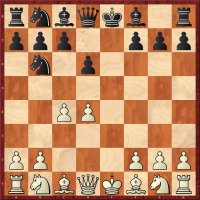 |
|
With 4.c4 and the exchange on d6 White is not
being particularly ambitious, But Black must
still know what he is doing. As Marin shows in
his article, really accurate play is even
required, and sometimes the precise order of
opening moves has its role to play. |
Grivas: Sicilian B33
1.e4 c5 2.Nf3 Nc6
3.d4 cxd4 4.Nxd4 Qb6
5.Nb3 Nf6
6.Nc3 e6 7.Bg5
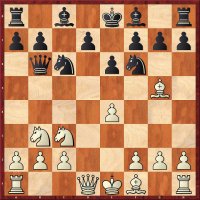 |
|
In the second part of his series on the Grivas
Sicilian our Greek author looks into White’s
bishop move 7.Bg5
(the Poseidon Variation), which is not
especially popular but which does have a certain
significance, because positions arise there
which are also reached by other move orders. |
Kritz: Sicilian B42
1.e4 c5 2.Nf3 e6 3.d4 cxd4 4.Nxd4 a6 5.Bd3 Bc5
6.Nb3 Be7
7.Qg4 Bf6
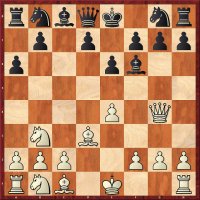 |
|
The bishop manoeuvre Bc5-e7-f6
is just as unusual as it has previously been
successful. But Kritz sketches out here an as
yet unplayed setup which promises White an
advantage. |
Kuzmin: Sicilian B94
1.e4 c5 2.Nf3 d6 3.d4 cxd4 4.Nxd4 Nf6
5.Nc3 a6 6.Bg5 Nbd7
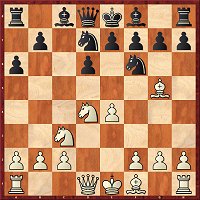 |
|
The knight move is not reckoned to quite good
enough by the top players, but that could
change. Alexey Kuzmin has brought together the
latest developments and can see splendid
counterplay for Black. |
Moskalenko: French Defence C00
1.e4
e6 2.b3 d5 3.Bb2
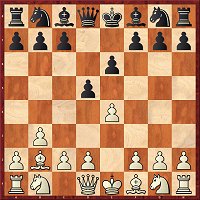 |
|
Black needs to know what he is doing against the
Reti Gambit, because it is difficult to find the
correct moves over the board. In a very
concentrated survey Moskalenko shows how things
go. |
Langrock: French Defence C11
1.e4 e6 2.d4 d5 3.Nc3 Nf6
4.e5 Nfd7
5.f4 c5 6.Nf3 Nc6
7.Be3 cxd4 8.Nxd4 Bc5
9.Qd2 0-0 10.0-0-0 a6
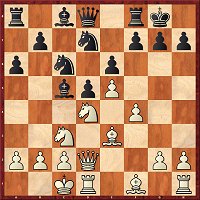 |
|
The evaluation of the position in the diagram is
of enormous importance for the evaluation of the
move 4.e5 and with it the whole Steinitz System. Langrock’s
investigation is appropriately thorough. |
Hazai/Lukacs: Scotch
C45
1.e4
e5 2.Nf3 Nc6
3.d4 exd4 4.Nxd4 Bc5
5.Be3 Qf6
6.c3 Nge7
7.Qd2
 |
|
After the move 7.Qd2
(instead of the main variation 7.Bc4)
there are numerous wrong replies, but the
authors show that after the correct moves,
7...a6 and 7...0-0 Black has good prospects. |
Skembris: Two Knights Defence C58
1.e4
e5 2.Nf3 Nc6
3.Bc4 Nf6
4.Ng5 d5 5.exd5 Na5
6.Bb5+ Bd7
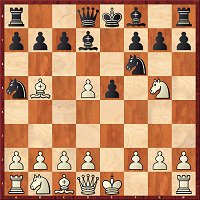 |
|
Apparently Black’s prospects after 6...Bd7
instead of the main move 6...c6) have so far
been underestimated, because, as our author
shows, Black has several promising continuations
after 7.Qe2 Be7
8.Nc3
0-0 9.0-0. |
Erenburg: Ruy Lopez C65
1.e4
e5 2.Nf3 Nc6
3.Bb5 Nf6
4.d4
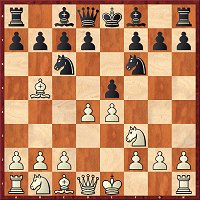 |
|
With the move 4.d4 White can in a radical
fashion prevent the Berlin endgame. Some of the
resulting variations are very sharp and Black
must also work hard for equality. |
Postny: Ruy
Lopez C65
1.e4
e5 2.Nf3 Nc6
3.Bb5 Nf6
4.0-0 Bc5
5.c3 0-0 6.d4 Bb6
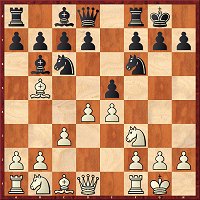 |
|
After looking at 5.Nxe5
in CBM 134 our Israeli author now examines the
main variation, which begins with 5.c3. But
recent games have shown that here too it is
difficult for White to achieve an opening
advantage. |
Karolyi: Queen's Gambit Accepted D24
1.d4
d5 2.c4 dxc4 3.Nf3 c5 4.d5 e6 5.Nc3
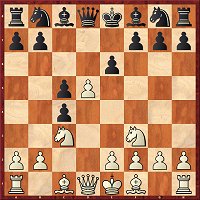 |
|
Our Hungarian author, who helped develop the
theory of his variation over 20 years ago,
suggests at this point two continuations for
Black - 5...exd5 and 5...Nf6
- and both appear to lead to equality. |
|
Krasenkow: Queen's Indian Defence E12
1.d4 Nf6
2.c4 e6 3.Nf3 b6 4.a3
 |
|
In the first part of his series on the
Petrosian System the author looks into
variations in which Black does not play
4...Bb7. Here
Black just scrapes past equality. |
|